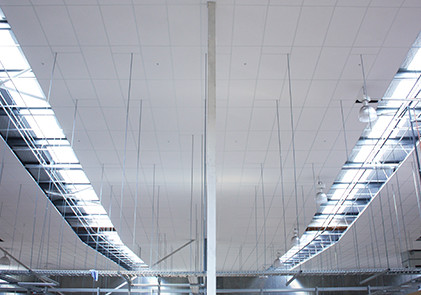Here are four key ideas.
1. Good Acoustic Design
Absorptive materials reduce sound, whereas reflecting materials amplify it. You may think that high absorption is always better (and it often is), but sometimes a more nuanced option means better results. Classrooms, for example, benefit from having reflective surfaces near the teacher and absorptive surfaces above pupils.
Potter's fleece-faced panels – such as AMF's Thermatex Acoustic R/L and dB Acoustic – appear identical but have varying acoustic properties (reflective and absorptive, respectively). In other words, you don't need a patchwork ceiling to have a combination of acoustic properties.
2. Insulate or Screen Outside Noise
Did you know that rain noise can reach as high as 80dB? That's the same sound level as the annoying drone of a vacuum cleaner - a nuisance to say the least. This noise can dramatically affect speech intelligibility.
Ceiling panels with high CAC (Ceiling Attenuation Class) can significantly reduce this noise. The AMF dB Acoustic (with a CAC of 41dB) is a good option.
3. Reduce Noise from Adjacent Rooms
Ceiling panels with high CAC will reduce noise travelling over the ceiling space where the dividing wall doesn't connect to the structural ceiling.
Insulating walls with specialised acoustical insulation is another worthwhile option. Bradford Gold Acoustic Partition Blanket (available from Potters) is a lightweight insulation product specifically designed for the acoustic insulation of partitions and intertenancy walls.
Other than including absorptive surfaces in your designs, you could also utilise ST-001 Sound Isolation Clips to minimise the acoustic vibrations of your walls and ceilings.
4. Reduce Reverberation Time
Speech intelligibility largely depends upon the reverberation time of the room or space.





























 Most Popular
Most Popular Popular Products
Popular Products



